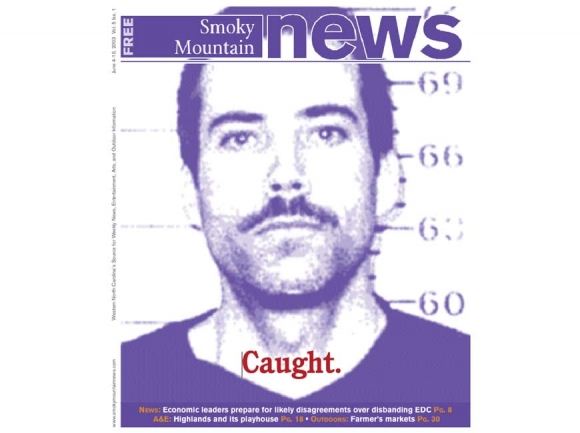2003: The end of Eric Rudolph’s run

He was a seasoned dumpster diver by now. For the last three summers, he’d regularly swoop down in the dead of night to go “shopping,” collecting fruits and veggies to preserve for the winter.
It was just another summery Saturday night and he knew the Murphy cops would be more plentiful than usual, but he also knew that the box of bruised bananas he’d snagged days earlier heralded a forthcoming cornucopia of discarded produce ripe for the picking.
He’d dodged those squads a hundred times — now a hundred and one, as he watched one from afar cruise slowly behind the Save-A-Lot grocery store.
Minutes later, within moments of his harvest, he was shocked to see that same car, headlights off, whip back around the building and catch him out in the open.
Ducking for the first available shelter, a stack of milk crates, he found himself backed into a corner against the loading dock, hoping he hadn’t been spotted by the 21-year-old rookie, whose spotlight said otherwise. He briefly thought to flee, until he heard a voice inside his head.
“Stop running,” it said.
Related Items
A militant’s mindset
Eric Robert Rudolph was born in Merritt Island, Florida, in 1966. In 1981, upon the death of his father Bob, an aircraft mechanic, Rudolph and his mother moved to Macon County. After dropping out of the Nantahala School upon completion of his freshman year, he worked around the region as a carpenter and handyman with his older brother, Daniel.
Around 1984 he left to Schell City, Missouri, where his mother was living at a compound run by the Church of Israel, an anti-government, anti-vax Christian Identity group that espouses Biblical justifications for white supremacy.
Their stay was brief — just a few months — but would prove pivotal in helping shape who Eric Rudolph was, and who he’d soon become.
Three years later and after earning a GED, Rudolph enlisted in the U.S. Army, ultimately becoming a rifleman in the 101st Airborne Division before his discharge for marijuana use in 1989.
Rudolph’s expansive, self-penned 154,000-word 2013 tome Between the lines of drift: memoirs of a militant, reads as much as a prepper paean as it does a political manifesto; in it, he lays bare how he did what he did, and why, albeit with some significant gaps.
By the early 1990s, Rudolph had developed substantial disdain for what he called the progressive policies of President Bill Clinton.
In language eerily reminiscent (prescient?) of today’s Overton window, Rudolph decries socialized medicine, multinational corporations, feminism, homosexuals in the military, the purportedly imminent mass confiscation of firearms and an impending new world order. He invokes the John Birch Society, philosophers Thomas Hobbes and John Locke, the incidents at Waco and Ruby Ridge and, most pointedly, what he sees as a federal government far too permissive of abortion.
“I was convinced that an illegitimate government controlled our country. And if all peaceful efforts to remove it had failed, then the only alternative was to remove it by force. Naturally, I couldn’t do it alone. I had no delusions on that score. I had to somehow encourage others to help,” he wrote. “In the spring of 1995, I decided to embark on a mission. I’d carry out a series of high profile attacks against symbols of the regime: abortion mills, Sodomite organizations, left-wing interest groups, and agents of the Washington government. Because it is the most egregious of Washington’s many crimes, abortion would be the main focus of my attacks.”
The bombings begin
Around 1:20 a.m. on July 27, 1996, a massive 100-pound pipe bomb concealed within a backpack exploded in Atlanta’s Centennial Olympic Park, where many thousands had gathered in conjunction with the events of the 26th Olympiad. It wounded 111 people, killed one spectator and led to the heart attack death of a television cameraman hustling to the scene.
Rudolph said that when he planted the bomb and initiated the timer, he intended to make a 911 call from a pay phone and give an hour’s notice to authorities who would then hopefully clear the park and thereby minimize casualties, but logistical problems delayed that call for 40 minutes.
About 10 minutes before Rudolph made the call, AT&T security guard Richard Jewell saw something glaringly out of place — an unattended backpack — and contacted the Georgia Bureau of Investigation. Although his discovery saved many lives, Jewell went on to become a suspect who was tried viciously in the media until formally cleared by a U.S. Attorney months later. Jewell would go on to file several libel suits, settling with the New York Post and CNN for an undisclosed amount and with NBC for $500,000.
Meanwhile, Rudolph had high-tailed it home, stopping briefly at his trailer south of Murphy to pick up the gear and grub he’d cached, and hid out near the Tennessee border in his truck, listening to the radio.
During that time, he expressed frustration that what he thought would be a bold and sophisticated political statement against “global socialism” that was meant to embarrass Washington for its sanctioning of abortion instead ended up looking like an arbitrary attack on innocents.
He probably learned on that radio that his attack “paused” the Olympics for exactly one day, and he also may have at some point heard the theme song of the 1996 Games — “Imagine,” by John Lennon — performed at the closing ceremonies Aug. 4 by Stevie Wonder.
After three weeks, when no one came calling, Rudolph went home.

Law enforcement officers set up roadblocks throughout the region the day Eric Rudolph was captured on June 3, 2003.
On the run
The Olympic bombing was only the start of Eric Rudolph’s foray into domestic terrorism; after spending six more months making preparations, he bombed an abortion clinic near Atlanta in January 1997, injuring six. A month later, he did the same at an Atlanta bar frequented by lesbians, injuring five. A year later, in January, 1998, it was another clinic in Birmingham, killing one.
Two weeks later, two men who’d seen Rudolph depart the scene gave authorities his license plate number. He was named as a suspect in the Birmingham incident, and added to the FBI’s Ten Most Wanted List three months after that. In October 1998, he’d also be linked to the three Atlanta attacks.
But by then, Rudolph had already started running. After hearing a radio news report about a grey truck linked to the bombing — his truck — he loaded up for remote Fires Creek, northwest of Hayesville. He’d go on to spend the next five years stealing from grain silos, residential gardens and dumpsters around Murphy while using Fires Creek as a base camp.
Longtime Smoky Mountain News contributor Don Hendershot didn’t know any of that before he penned his story for the June 4, 2003, edition of the Smoky Mountain News, the cover of which prominently featured Rudolph’s mug along with just one word — “Caught.”
Hendershot has long been a familiar face to SMN readers as the author of a recurring column called “The Naturalist’s Corner” wherein he shares his knowledge of and adventures throughout Western North Carolina’s majestic outdoors with all the guile and grace of an award-winning outdoors writer, which is exactly what he is.
As such, he was familiar with the area in which Rudolph was hiding out, and also with the opinions of other local outdoors enthusiasts at the time.
“I don’t think anyone actually thought, ‘If I go into the Nantahala Gorge, I might run into Eric Rudolph.’ The idea that you’re going to go on a hiking trail and run into Rudolph hiding in the woods, I don’t think that crossed too many peoples’ minds,” Hendershot said last week. “He was thought of more as a fugitive who was going to hide, scared that someone would recognize him.”
With a $1 million reward offered for information leading to his capture, Rudolph kept a low profile and changed locations often, even as some foolhardy adventurers went out in search of him.
So did the FBI’s Southeast Bomb Task Force, which soon set up shop in Andrews and went on to spend $25 million looking for him, just as he watched their comings and goings from a nearby ridge top.
How he was able to last so long remains a subject of great speculation.
On one hand, he was a well-prepared, zealous survivalist with military training who was operating on his home turf — a rugged scrap of isolated, mountainous terrain home to a people with a long history of dogged independence.
“Especially where he was, in 1998, the old iconic Appalachian mountaineer doesn’t care what you’re doing,” Hendershot said. “You mind your business and I’ll mind mine. If they saw somebody walking down the road, only thing they would probably do is offer him a ride.”

On the other hand, those isolationist leanings made Rudolph something of a folk hero to some; bumper stickers and T-shirts began to appear with the words, “Run, run Rudolph!” — a play on an old Chuck Berry Christmas tune.
“He was kind of an enigma, as someone who was out there, but when you get to Murphy and Andrews, the story changes a little bit,” said Hendershot. “I remember when I went over there and stopped in Andrews and talked to some people, the idea was, well, Eric Rudolph may have done some bad things, but it’s not any worse than what the government does.”
Two men even shot up the FBI’s command post in 2000, reportedly grazing one agent’s hair, but the FBI still maintains that Rudolph was far too paranoid and distrustful of others to seek or accept help, from anyone. Others, though, disagree.
“The idea that Eric Rudolph spent five years in the woods alone, I think there are a lot of people that would argue the point that he had a lot of help,” Hendershot said.
One theory is that there was a specific person who was helping Rudolph, but that person passed away at some point, making things more difficult for Rudolph, perhaps even leading him to get risky, to get sloppy, to take chances — like the one he took behind the Save-A-Lot in Andrews on Saturday, May 31, 2003.
Caught
After more than five-and-a-half years on the run, Rudolph had finally backed himself into a corner.
“Stop running,” said the voice in his head, a stack of crates the only thing standing between him and Murphy Police Officer Jeff Postell’s cruiser. “You can take whatever they throw at you.”
In exchange for taking the death penalty off the table, Rudolph pled guilty to charges stemming from the bombings in Birmingham as well as all three Atlanta attacks, including the one in Centennial Olympic Park.
What they threw at him was four life sentences plus 120 years in Florence, Colorado’s Supermax — possibly the world’s most secure prison — where he spends 23 hours a day in a 7-by-12 cell. No more running, and probably no more free than he was while hiding out in the mountains of Western North Carolina.









